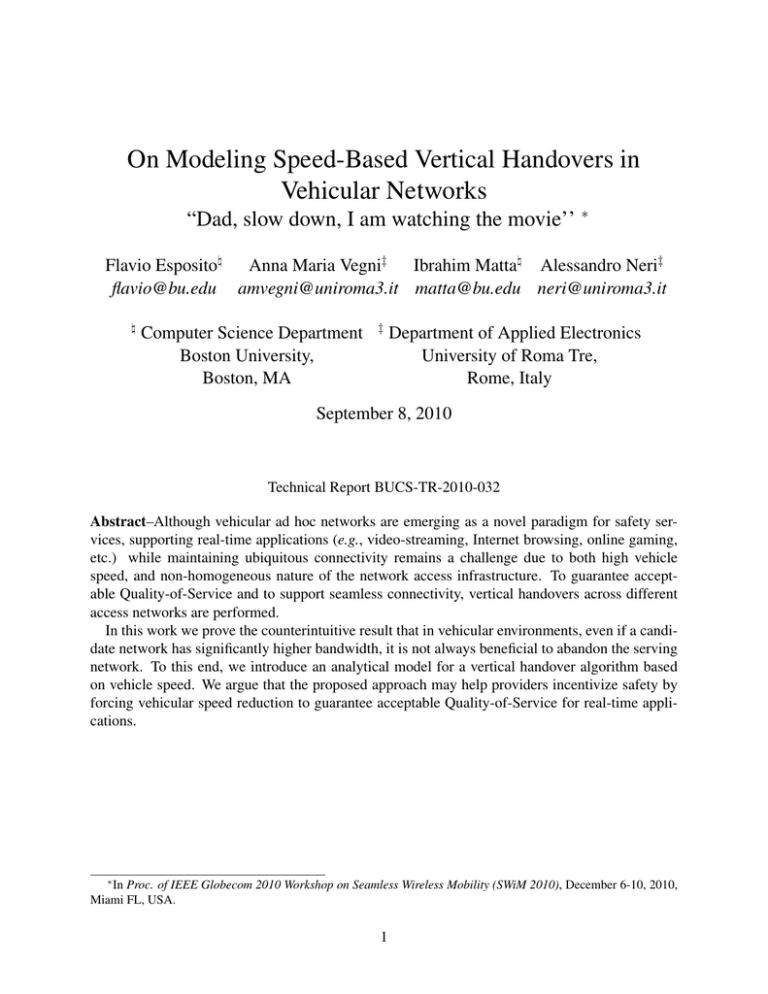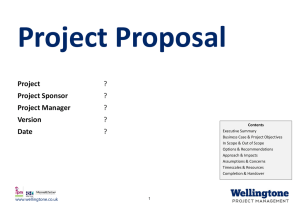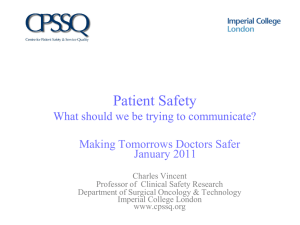On Modeling Speed-Based Vertical Handovers in Vehicular Networks
advertisement

On Modeling Speed-Based Vertical Handovers in
Vehicular Networks
“Dad, slow down, I am watching the movie’’ ∗
Flavio Esposito\ Anna Maria Vegni‡ Ibrahim Matta\ Alessandro Neri‡
flavio@bu.edu amvegni@uniroma3.it matta@bu.edu neri@uniroma3.it
\
Computer Science Department
Boston University,
Boston, MA
‡
Department of Applied Electronics
University of Roma Tre,
Rome, Italy
September 8, 2010
Technical Report BUCS-TR-2010-032
Abstract–Although vehicular ad hoc networks are emerging as a novel paradigm for safety services, supporting real-time applications (e.g., video-streaming, Internet browsing, online gaming,
etc.) while maintaining ubiquitous connectivity remains a challenge due to both high vehicle
speed, and non-homogeneous nature of the network access infrastructure. To guarantee acceptable Quality-of-Service and to support seamless connectivity, vertical handovers across different
access networks are performed.
In this work we prove the counterintuitive result that in vehicular environments, even if a candidate network has significantly higher bandwidth, it is not always beneficial to abandon the serving
network. To this end, we introduce an analytical model for a vertical handover algorithm based
on vehicle speed. We argue that the proposed approach may help providers incentivize safety by
forcing vehicular speed reduction to guarantee acceptable Quality-of-Service for real-time applications.
∗
In Proc. of IEEE Globecom 2010 Workshop on Seamless Wireless Mobility (SWiM 2010), December 6-10, 2010,
Miami FL, USA.
1
1
Introduction
In Vehicular Ad hoc NETworks (VANETs) vehicles endowed with sophisticated “on-board” equipment communicate with each other, and with the wireless and cellular network infrastructure by
means of several network interface cards (i.e., IEEE 802.11, WiMAX, UMTS, HSDPA, and so
forth [1]).
Future networked vehicles represent the future convergence of computers, communications infrastructure, and automobiles [2]. An envisioned goal is to embed human-vehicle-interfaces such
as color reconfigurable head-up and head-down displays, and large touch screen active matrix
liquid crystal displays, for high-quality video-streaming services [3]. Passengers can enjoy their
traveling time by means of real-time applications, e.g., video streaming and online gaming, using
individual terminals next to their seats (Figure 1 (a)).
To guarantee the delivery of acceptable Quality-of-Service (QoS) in such environments, Vehicleto-Infrastructure (V2I) communications represent a viable solution. However, V2I protocols still
lack seamless connectivity: when vehicles encounter an area with overlapping wireless networks,
a decision on whether or not a connectivity switch should be executed has to be taken. The mechanism preserving on-the-move user’s connectivity is defined as Vertical Handover (VHO) [4].
In this paper we show that in VANET scenarios with a heterogeneous network access infrastructure, bandwidth gains are tightly coupled with the protocol overhead —handover latency—
and the speed of the vehicle. Leveraging on this consideration, we propose a new speed-based,
QoS-oriented Vertical Handover algorithm for vehicular networks. In the rest of the paper we refer
to our algorithm as S-VHO. The idea of using the vehicle speed as assessment criterion for vertical
handovers has been floated before [5, 6]. However, our emphasis lays on real-time applications
for VANETs. As a baseline of comparison for our simulations, we consider the recent work of
Yan et al. [5], whose algorithm is based on both the Received Signal Strength (RSS) level and the
terminal speed, and we show that our S-VHO algorithm outperforms their approach, in terms of
throughput, delay, jitter, and overhead (number of vertical handovers).
The paper is organized as follows. In Section 2 we present an analytical model useful to compute a speed upper bound used by our S-VHO algorithm, described in Section 3. Analytical and
simulation results are shown in Sections 4, and 5, respectively. We discuss some related work in
Section 6, and in Section 7 we conclude our paper.
2
Analytical Model
In this section, we present the counterintuitive result that in heterogeneous vehicular networks, connectivity switches are justified only when the vehicle speed satisfies a given speed upper bound.
To compute this bound we need to formally define (i) a valid handover in VANETs, (ii) the cell
crossing time (i.e., the time a vehicle spends inside a wireless cell), and (iii) the handover latency.
Definition 1 (Valid Handover in VANETs): A vehicle crossing an area covered by at least two
wireless networks performs a valid handover if, and only if, the handover results in a throughput
increase.
Note that there exist two main types of handover, horizontal—when the two cells involved in
2
handover if and only if the handover results in a throughput
increase. 1
Our model assumptions are depicted in Fig. 1 (c). A vehicle
is moving at constant speed !
v in a vehicular environment, with
a network infrastructure composed of several overlapping heterogeneous wireless networks, partially covering the road. The
vehicle’s trajectory is constrained by the road, composed by a
straight lane, (i.e. Manhattan mobility model) [8]. Moreover,
each vehicle is equipped by an on-board Global Positioning
System (GPS) network interface card, so that the vehicle
position is always known.
50
BS
UMTS Cell Crossing Time
B. Modeling
100
AP
We WLAN
start modeling the cell crossing time—the time that a
vehicleR spends inside a wireless cell. Formally, we have:
Pin ,t in
Definition
! 2 (Cell Crossing Time): Given a vehicle V,
traversing an area covered by a wireless cell C with a
!x
! > 0, the cell crossing time of
constant speed !
v such that |v|
V in C, denoted as ∆T , is the overall time that V can spend
inside C.
250
300
350
(a)
∆T =
∆x
=
|!
v|
From these assum
that the vehicle wo
the Serving Networ
tout − tin , as a fun
constant during ∆T
Notice that so fa
in a VANET netwo
service network; we
150
200
Pout ,t out
Thus, the cell cro
well-defined terms,
400
(b)Denoting by tin
50
100
150
200
250
300
350
400
(c)
the time in which a vehicle enters an area
covered by a considered wireless cell, we model the exit time
C. Network Switche
In this Subsectio
in our ad-hoc netw
vehicle, through the
handover decisions
parameter in our m
Definition 3 (Ha
traversing an area
the handover latenc
does not receive an
messages exchange
the cell as:
Figure 1: (a) Video-streaming applications for from
on-the-move
users, (b) Manhattan
mobility model
∆x
tout = tin +
,
(1)
|!
v
|
for a VANET scenario with heterogeneous overlapping wireless networks, (c) Simulated VANET
Let a
where ∆x is the distance covered inside the wireless cell in
scenario.
the time interval tout − tin . In particular, if we denote as R ∈ entering
#+ \ {0} the radius of the omnidirectional wireless cell, and
as φ ∈ [0, π], the angle between the vehicle’s line of sight with
the cell’s antenna and the movement direction of the vehicle,
we have ∆x = 2R cos φ.
Notice that ∆x is known since we have assumed each
vehicle equipped with a GPS receiver, so that coordinates of
the entrance, and exit points of the cell are easy calculated as:
Pin ≡ (xin , yin ), and Pout ≡ (xout , !
yout ). Therefore,
the angle
"
out −yin
φ can be computed as φ = arctan xyout
.
−xout
vehicle be
the wirele
In this non-homoge
between the data c
tout as:
Θ(tout )
the process belong to the same technology—and vertical—when the two cells belong to different
technologies. Although Definition 1 holds for any type of handover, in this work we focus on where γ is a positiv
γ = α · (BCN
vertical handovers between WLAN and UMTS, and vice versa.
Our model assumptions are depicted in Figure 1 (b). A vehicle is moving at speed ~v in a ve- and α is an indicato
handover is execut
hicular environment with a network infrastructure Notice
composed
of several
overlapping
heterogeneous
α = 1, γ is equivale
that there exist
two main types
of handover, horizontal—when
the
cells involved in the process belong to the same wireless technology—
while for α = 0, γ
wireless access networks, partially covering the two
road.
The
vehicle’s
trajectory
follows
a
Manhattan
and vertical—when the two wireless cells belong to different technologies.
Through the hys
Although definition 1 holds for any type of handover, in this work we focus
on vertical
handovers for of
WLAN,
and UMTS
technologies.
mobility model, and it is constrained by the road,
composed
straight
lanes.
Moreover, each due to the vertical
vehicle is assumed to be equipped with an on-board Global Positioning System (GPS) network
interface card, so that the vehicle position is ubiquitously known.
1
Definition 2 (Cell Crossing Time): Given a vehicle V , traversing an area covered by a wireless
cell C at constant speed |~v |, the cell crossing time of V in C, denoted as ∆T , is the overall time
that V can spend under C’s coverage.
Denoting by tin the time at which a vehicle enters in an area covered by a wireless cell, we model
the exit time from the same cell as:
∆x
,
(1)
tout = tin +
|~v |
where ∆x is the distance covered inside the wireless cell in the time interval ∆T = tout − tin . In
particular, if we denote as R ∈ <+ \ {0} the radius of the omnidirectional wireless cell, and as
φ ∈ [0, π], the angle between the vehicle’s line of sight with the base station and the vehicle motion
direction, by simple geometric consideration we obtain ∆x = 2R cos φ.
Since we have assumed that each vehicle is equipped with a GPS receiver, the coordinates Pin ≡
(xin , yin ) of the entrance, and Pout ≡ (xout , yout ) of the exit point of the new (candidate) cell, with
respect to a coordinate system centered in the cell centre, are easily calculated so that ∆x is known.
It follows that the cell crossing time is expressed as 1 :
∆x
2R
yout − yin
∆T =
=
· cos arctan
|~v |
|~v |
xout − xin
1
.
(2)
This computation is directly performed by the vehicle by assuming constant vehicle speed, and knowledge of the
new cell radio coverage.
3
Given the above assumptions and definitions, we can model the throughput Θ that a vehicle
would experience by remaining connected with the Serving Network (SN), during the cell crossing
time ∆T , as a function of the bandwidth BSN , assumed to be constant during ∆T . Namely, we
have:
Θ = ∆T · BSN .
(3)
Note that so far we have only modeled the throughput in a VANET network where vehicles are
covered by a single service network. We now extend the model to heterogeneous environments by
capturing network switches as well.
Definition 3 (Handover Latency): Given a vehicle V , traversing an area covered by at least
two wireless cells, the handover latency L is the time interval during which V does not receive any
data due to control plane (socket switching) signaling messages exchange.
Let a vehicle be connected to a SN, entering the wireless range of a Candidate Network (CN).
In this heterogeneous scenario, we model the data delivered between the two time instants tin and
tout , as a positive range function γ : < → <+ , defined as:
γ = α · (BCN − δ) (∆T − L) + (1 − α) BSN ∆T,
(4)
where α is an indicator function, such that α = 1 when a vertical handover is executed, and zero
otherwise. Note that when α = 1, γ is equivalent to the throughput obtained in the CN, while for
α = 0, γ is the throughput in the SN.
Function γ captures the data loss due to the vertical handover latency L. Since during the traveling time of a vehicle it is desirable to maximize throughput, our technique initiates an handover
only when it is “valid”, that is, when γ|α=1 > γ|α=0 and so when the inequality
BCN >
BSN
+δ
1 − L/∆T
(5)
holds. In (5) δ ∈ <+ is a hysteresis factor introduced to avoid vertical handover occurrence when
the two competing networks have negligible bandwidth difference. From (5), we note how switching decisions may not be necessary even though the bandwidth BCN is higher than BSN . Switching
becomes necessary only if the time that the vehicle will spend in the cell with higher bandwidth
is long enough to compensate for the data loss due to the switching overhead, namely, only if
L < ∆T holds. This observation leads to the conclusion that the throughput is influenced not
only by the bandwidth of the considered technologies, but by a larger set of parameters: the crossing time, the vehicle speed, and the overhead of the control-plane protocols adopted (handover
latency). We formalize this intuition with the following:
Theorem (Speed Upper Bound): Given a vehicle V , traveling with an average speed ~v in a
heterogeneous vehicular environment for a distance ∆x, a valid handover for V occurs if |~v | is
bounded as follows:
∆x (BCN − BSN − δ)
|~v | <
.
(6)
(BCN − δ)L
4
Proof: the claim follows from (5), and from the definition of average speed of a vehicle: ~v =
∆~x/∆T . 2
In the rest of the paper we show how the above result is useful in designing V2I protocols,
as well as to promote vehicle safety applications. Providers may in fact offer lower data rate in
those areas where the speed limit is lower, to induce vehicles to maintain lower speeds, in order to
experience acceptable QoS levels —low jitter and high throughput— throughout valid handovers.
3
Speed-Based Vertical Handover Algorithm
We now present our S-VHO algorithm, and then discuss a related solution, i.e. Speed ProbabilityBased VHO (SPB) [5], which we compare against in our simulations. In both solutions, the speed
of the vehicle is used as handover assessment criterion.
Consider Algorithm 1. Our S-VHO accepts three inputs (i) the vehicle speed ~v , (ii) the ingress
time tin of the vehicle into a wireless cell, and (iii) the GPS location information Pin , and then
returns the handover decision variable α ∈ {0, 1}.
Let a vehicle connected to a SN, entering into an area with also a CN coverage. When (5) holds,
the cell crossing time ∆T is computed as shown in (2). S-VHO decides if an handover would be
valid or not by comparing ∆T with the threshold for valid handovers ∆T ∗ , such as 2
∆T ∗ =
2R cos φ L (BCN − δ)
∆x
=
.
∗
v
∆x (BCN − BSN − δ)
(7)
After each handover execution, the algorithm enters in idle mode for an inter-switch waiting
time period, Tw . For example, if a vehicle travels at 15 m/s, a 10 seconds inter-switch waiting time
results in 150 meters covered by the vehicle, before the algorithm is re-activated. This shrewdness
is necessary to avoid a high handover frequency that may occur when vehicles travel on a border
line between two wireless cells (ping-pong effect [7]).
The SPB technique instead focuses on an adaptive handover mechanism, based on the evaluation
of a handover probability Pho , obtained from power measurements [5]. The handover decision is
taken by comparing the handover probability with a fixed probability threshold PT , that depends
on both the vehicle speed and on the handover latency. In particular, a handover from UMTS to
WLAN is executed if
v
λ · RXth − RXW
> 2R 2R·BU = PT ,
(8)
Pho =
λ · RXth − RXth
−
L
L·BW
where λ is a coefficient whose larger value means more difficulty to perform handover, RXth is
the threshold value of RSS denoting the successful packet receipt, RXW the currently measured
RSS in WLAN, R is the WLAN cell radius, L is the average handover latency between WLAN
and UMTS, while BU and BW are the data rate of UMTS and WLAN, respectively.
In the rest of the paper we show how, although both approaches consider data rates and handover
delays, Equation (8) of SPB, using RSS (fluctuating) measurements, does not explicitly estimate
throughput gains, and sometimes confuses the handover decision suggesting throughput gains from
switching when there are none.
2
This is computed using the speed bound v ∗ , obtained from inequality (6), and considering that ∆T ∗ = ∆x/v ∗ .
5
Input: ~v , tin , Pin
Output: α (handover decision)
while inside area with at leasttwo overlapped cells do
L
if (BCN > BSN / 1 − ∆T
+ δ) then
α ← 1 (VHO executed)
set a decreasing counter to Tw [s].
while Tw > 0 do
idle mode
end
else
α←0
end
end
Algorithm 1: Speed-based Vertical Handover Algorithm.
4
Analytical Results
In this section we dissect the impact of both the handover latency, and the hysteresis effects on the
speed upper bound computed in Section 2 with some analytical results.
In Figure 2 (a) we show the impact of the handover latency on the speed upper bound, for a
given bandwidth ratio of available technologies. The bandwidth ranges were chosen according
to WLAN [8], and UMTS [9] requirements. The hysteresis factor δ was set to zero to isolate
the impact of the single parameter L (handover latency), and the range of speed was bounded by
35 m/s, being a common highway speed limit.
The first take-home message confirms the validity of our model, revealing that for higher values
of handover latency, the speed bound (i.e. the maximum speed at which vehicles experience valid
handovers) decreases. This makes sense since vehicles traveling at higher speed may not spend
enough time under higher data-rate cells to justify the degraded performance introduced by the
handover overhead of the signaling messages.
The second result comes by observing the epigraph —the set of points above the drawn curves.
Any point belonging to the epigraph represents no performance gain in initiating handovers, even
if the CN has higher bandwidth than the SN. In contrast, for any point in the hypograph —the
set of points below the curve— valid handovers occur. As a limit case study, note how the curve
with zero bandwidth gap has empty hypograph; this follows directly from the definition of valid
handover: an handover cannot be valid when the data rates are equal.
In Figure 2 (b) we show the impact of the hysteresis δ [Mbps] on the speed bound, given the
handover latency L [s]. We considered the hysteresis range to be δ ∈ [0, BCN − BSN ] and we
have simulated the case BCN − BSN = 16 [Mbps], a typical gap in data rates between UMTS and
WLAN [8,9] . It is useful to note that BCN − BSN is the maximum δ after which no valid handover
would occur.
The message for this simulation setting concerns the difference in the hypographic area for
different values of L: when the handover latency increases, the hypographic area significantly
reduces. From this observation, it follows that handover latency should be taken into account when
designing protocols for seamless connectivity in VANET, instead of considering only physical
6
BSN = 18 Mbps, BCN = 2 Mbps
60
{BCN,BSN}= {18,2} [Mbps]
30
{BCN,BSN}= {18,5} [Mbps]
25
{BCN,BSN}= {18,9} [Mbps]
Speed Upper Bound [m/s]
Speed Upper Bound [m/s]
35
{BCN,BSN}= {18,14} [Mbps]
20
{BCN,BSN}= {18,18} [Mbps]
15
10
5
0
!2
10
40
10
(a)
L = 0.01 [s]
L = 0.02 [s]
L = 0.04 [s]
L = 0.08 [s]
30
20
10
0
!1
10
!1
Handover Latency [s]
50
0
10
Hysteresis (!) [Mbps]
1
10
(b)
Figure 2: Performance of Speed Upper Bound. Impact of (a) handover latency, and (b) hysteresis.
parameters or speed of the vehicles.
5
Simulation Results
In this section we report on network performance, i.e. throughput, delay, and jitter, as well as the
number of vertical handovers obtained using our event-driven simulator. Details of the simulator
can be found in [10].
Simulation Scenario: A vehicle enters from a random location and is restricted to travel along
a grid of streets and intersections, following a path inside a grid. Figure 1 (c) depicts one of the
simulation scenarios, in terms of data rate distribution from three UMTS base stations, and twenty
WLAN access points, in a region of 2 km2 . Typical data rate values have been considered for
UMTS and WLAN, respectively [8, 9] and network parameters have been set according to [11].
The location of each wireless cell has been generated uniformly at random, and a vehicle moves in
this RSS-variable area with speed in the range [5, 35] m/s. A vehicle downloads a series of video
frames during its journey.
Network Performance: In Figure 3 (a) we show the throughput as cumulative received bits in
a downlink connection for both S-VHO and SPB techniques, versus the inter-switch waiting time.
The effectiveness of S-VHO is clear when vehicle speed is below a given limit (e.g., 20 m/s). On
the other hand, SPB does not appear sensitive to either speed or inter-switch waiting time, and its
throughput is limited. Note however, the S-VHO throughput drops when the vehicle speed exceeds
the desired limit.
Figure 3 (b) shows, with 95% confidence intervals, how the average frame delay for both SVHO and SPB increases for higher speeds. This is because there is not enough time to download
the next frame before the signal from the SN gets too weak. Moreover, S-VHO experiences lower
delays compared to SPB, since, on average, it performs less handovers.
Jitter performance from S-VHO and SPB have been compared in Figure 4 (a), (b), (c), for
different values of speed, and a fixed inter-switch waiting time value of Tw = 10 [s]. Each point
represents the cumulative jitter, defined as the difference between maximum and minimum frame
delay, averaged over 100 simulations. As we can see, jitter increases with speed since two frames
7
9
6.5
x 10
6
Throughput [Bit/s]
12
10
10
S-VHO
20
30
40
1200
5 m/s
20 m/s
35 m/s
5 m/s
20 m/s
35 m/s
14
5
1000
50
8
600
SPB
S!VHO
S!VHO 5 m/s
S!VHO 20 m/s
S!VHO 35 m/s
SPB 5 m/s
SPB 20 m/s
SPB 35 m/s
500
800
600
400
400
300
200
6
200
100
4
10
20
30
Tw [s]
40
0
50
0
0
5
10
15
20
Speed [m/s]
(a)
25
30
10
35
20
(b)
30
Tw [s]
40
50
(c)
Figure 3: (a) Throughput averaged over 100 simulations for S-VHO (white markers), and SPB
(black markers). (b) Packet delay increases less rapidly with vehicle speed when using S-VHO. (c)
Number of Vertical Handovers for S-VHO (white markers), and SPB (black markers) algorithms.
2000
S!VHO
SPB
|Cumulative
Jitter|
[ms]
Cumulative
Jitter
[ms]
1000
800
600
400
200
0
0
20
40
60
Received Frames
80
100
(a) |~v | = 15 m/s, Tw = 10 s
12000
S!VHO
SPB
|CumulativeJitter
Jitter|[ms]
[ms]
Cumulative
1200
|CumulativeJitter
Jitter|
[ms]
Cumulative
[ms]
4.5
0
SPB
Number of VHOs
9
x 10
Delay [ms]
5.5
1500
1000
500
10000
S!VHO
SPB
8000
6000
4000
2000
0
0
20
40
60
Received Frames
80
100
(b) |~v | = 25 m/s, Tw = 10 s
0
0
20
40
60
Received Frames
80
(c) |~v | = 35 m/s, Tw = 10 s
Figure 4: Cumulative jitter experienced by a vehicle averaged over 100 simulations, for different
speeds —note the scale difference among different graphs. Higher speed implies higher jitter,
unless the number of unnecessary handovers is reduced (S-VHO).
may be more often coming from different wireless networks, and also because the cell crossing
time decreases when the speed increases.
Overhead (Handover Frequency): Figure 3 (c) depicts, with 95% confidence intervals, the
average number of handovers for different values of inter-switch waiting time Tw ∈ [0, 50] s. As
expected, the number of vertical handovers decreases when the system is idle for longer periods
(Tw increases). Since our simulations count all the handovers (valid or invalid), the gap between
the S-VHO and SPB curves represents the number of invalid handovers that are executed not taking
into account the handover latency L.
8
100
6
Related Work
A VHO decision is usually taken on the basis of (i) physical parameters, e.g. RSS level [7],
and (ii) QoS metrics [12]. QoS-based vertical handover algorithms mostly suggest that the user
connectivity should be switched to a candidate network, whenever the bandwidth is higher than the
currently experienced in the serving network, in order to improve perceived received quality [13].
Although this strategy seems reasonable, in vehicular environments it may fail due to the speed
and the time that the vehicle is going to spend in the new cell. In VANETs, vehicles move at high
speed, therefore handovers should be performed on the basis of specific factors as vehicle mobility
pattern, and locality information, rather than standalone QoS requirements. Past solutions have
partially but not fully considered these aspects. In [14], the authors deal with a novel network
mobility protocol for VANETs, to reduce both handover delay and packet loss rate, while Olivera et
al. [15] proposed the Always Best Connected paradigm, to achieve seamless connectivity between
WLAN and UMTS networks. Our method instead focuses on a vehicle-controlled VHO, due to
smart on-board computer equipped with GPS connectivity [1]. The idea of handover decisions
based on both vehicle speed and handover latency was previously introduced in [11]. We augment
our contributions by extending the algorithm’s usefulness to real-time applications, completing
the performance evaluation, and significantly extending the analytical results. We focus more on
jointly improving three QoS metrics (i.e. delay, jitter, and throughput), while keeping small the
number of vertical handovers.
7
Conclusions and Future Work
We have presented, via analytical modeling and a simulation study, a counterintuitive result for
vertical handovers in heterogeneous vehicular ad hoc networks, that is, when a vehicle encounters
a candidate network with higher data rate, a connection switch will not necessarily result in a
throughput improvement.
Our proposed technique uses both handover latency and cell crossing time estimation to simultaneously improve throughput and delay, and it is driven by the vehicle’ speed: vehicles are required
to maintain a given speed limit to maintain acceptable levels of throughput, delay and jitter. The
results presented in this paper are helpful for both the research community, when designing novel
VANET protocols for real-time applications, and the business community, as they suggest how
providers could enforce speed limits and therefore safety while delivering real-time services as
video-streaming or online gaming.
We plan to extend our analytical model into more realistic scenarios, removing the simplifying
assumptions of constant bandwidth across the coverage area, constant velocity and predictable
vehicle motion. Moreover, experiments comparing our handover algorithm with other QoS-based
approaches (using real data sets) are left for future work.
References
[1] H. Moustafa and Y. Zhang (Eds.), Vehicular Networks: Techniques, Standards and Applications, Auerbach publishers, 2009.
9
[2] R. Lind et al., “The Network Vehicle-a glimpse into the future of mobile multi-media”, IEEE
Aerospace and Electronic Systems Magazine, vol. 14, no. 9, pp. 27–32, Sept. 1999.
[3] “Backseat child navigation
http://www.slipperybrick.com/.
concept
for
kids”,
available
online
at
[4] G.P. Pollini, “Trends in handover design”, IEEE Communication Magazine, vol. 34, no. 3,
pp. 82–90, 1996.
[5] Z. Yan, H. Zhou, H. Zhang, and S. Zhang, “Speed-Based Probability-Driven Seamless Handover Scheme between WLAN and UMTS”, in MSN, Wuhan, China, Dec. 10-12, 2008.
[6] D. Kwak, J. Mo, and M. Kang, “Investigation of handoffs for IEEE 802.11 networks in
vehicular environment”, in ICUFN, Hong Kong, June 7-9, 2009, pp. 89–94.
[7] S. Balasubramaniam and J. Indulska, “Vertical Handover Supporting Pervasive Computing in
Future Wireless Networks”, Computer Communication Journal, vol. 27, no. 8, pp. 708–719,
2003.
[8] “IEEE Standard for Information Technology Telecomm. and Information Exchange between
Systems. Local and metropolitan area networks. Part 11: Wireless LAN MAC and PHY Layer
Specifications”.
[9] J. Laiho et al., Radio Network Planning and Optimisation for UMTS, 2nd edition, Dec. 2005,
Chapter 6.
[10] A.M. Vegni, Multimedia Mobile Communications in Heterogeneous Wireless Networks
-Part 2,
PhD thesis, University of Roma Tre, March 2010,
available online at
http://www.comlab.uniroma3.it/vegni.htm.
[11] A.M. Vegni and F. Esposito, “A Speed-based Vertical Handover Algorithm for VANET”, in
Proc. of 7th Int. Workshop on Intelligent Transportation, Hamburg, March 23-24, 2010.
[12] A.M. Vegni, M. Carli, A. Neri, and G. Ragosa, “QoS-based Vertical Handover in Heterogeneous Networks”, in Proc. of 10th Int. Symp. on Wireless Personal Multimedia Comm.,
Jaipur (India), Dec. 3-6, 2007.
[13] A.M. Vegni et al., “A Combined Vertical Handover Decision Metric for QoS Enhancement
in Next Generation Networks”, in WiCOM, Marrakech (Morocco), Oct. 12-14, 2009, pp.
233–238.
[14] Y.S. Chen, C.H. Cheng, C.S. Hsu, and G.M. Chiu, “Network Mobility Protocol for Vehicular
Ad Hoc Network”, in Proc. of IEEE Wireless Comm. and Networking Conf., Budapest, April,
2009.
[15] J.A. Olivera et al., “VANBA: a simple handover mechanism for transparent, always-on
V2V communications”, in Proc. on IEEE 69th Vehicular Technology Conference (VTC2009Spring), April 26-29, 2009.
10





